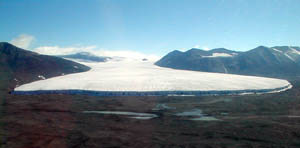|
|

|
|

|
The
Commonwealth Glacier flows down into the Taylor Dry
Valley.
Click
to enlarge
.
|

|
|
|
|

|
|
Glaciers
in the Desert
|

|
Antarctic
Dreams
by Paul Doherty
January
10, 2002
When
I was a high school student, I ordered a photograph of the
Commonwealth Glacier in Antarctica from the US Geological
Survey. I pulled the image from the envelope and stared in
awe at this strange glacier. It seemed to pour out from a
narrow gap in the mountains and flow down like thick pancake
batter forming a nearly perfect semicircle of white over the
dark rocks of the Taylor Dry Valley. The image screamed at
me "Glaciers Flow!" Then and there, I decided that
I wanted to see the Commonwealth Glacier with my own eyes.
This week I did.
A
helicopter carried Mary Miller and me into Lake Hoare Camp
in the Taylor Dry Valley. On our way to camp, we flew next
to the Commonwealth Glacier. I could see the mountains that
kept the dry valleys dry: They held back the ice that covered
98% of the Antarctic continent. Some ice managed to creep
through the gaps in the mountains and flow into the Dry Valleys.
In addition, the mountains themselves caught snow and created
glaciers which flowed into the valleys. But the valleys stayed
dry, beating the seemingly unstoppable flow of ice with wind;
dry katabatic wind pulled down by gravity from the polar plateau,
compressed and heated as it roared down toward the coast.
The wind evaporated the ice just as fast as it arrived. In
one of nature's greatest magic tricks, the glaciers in the
Dry Valleys vanish into thin air.
After
a welcome briefing at Lake Hoare Hut, I immediately hiked
over to inspect the face of the glacier. I had never seen
a glacier that ended in a cliff wall like this. The glaciers
that enter the Dry Valleys are rimmed by vertical walls over
60 feet high, higher than the five-story Palace of Fine Arts
that houses the Exploratorium. As the top of the glacier advances
over the bottom in a motion reminiscent of the track on a
caterpillar tractor, the face of the glacier gets steeper.
As it starts to overhang, it suddenly fails in an avalanche
of ice blocks. These blocks evaporate and melt in the sun
and wind, leaving a newly steepened glacier behind. This track-like
motion of the glacier is unique to polar glaciers.
My
excitement grew when Thomas Nylen invited me to join his team
on a data gathering expedition to the top of the Canada Glacier.
Thomas knew of one place where we could climb up a ramp through
the cliff wall. We had to put on crampons and use ice axes
to protect ourselves from falling as we climbed to the top.
|
|

|
|

|
Crampon-wearing
Virginia Butler and Thomas Nylen inspect a cryoconite
hole, while Sarah Tegt measures a stream.
Click
to enlarge
.
|

|
|
|
|

|
Once
on the surface of the glacier, I saw two strange things: dark
circles and meandering rivulets. The circular holes ranged
in size from as small as silver dollars up to the size of
children's wading pools. The rivulets rushed along on the
surface of the glacier. Virginia Butler, a volunteer on this
expedition, told me that these were the cryoconite holes that
I had heard about from Professor Andrew Fountain, the leader
of this research project. Winds deposit sediments on the glacier,
the sediments absorb sunlight and melt a hole in the glacier.
The water-filled holes become miniature ecosystems for life.
Sarah Tegt, a graduate student of glaciology, said that streams
often meandered along the top of polar glaciers while they
flowed inside or under temperate glaciers. Polar glaciers
have few crevasses to capture the streams. Sarah was measuring
the pH and also sampling the water flowing in all of the streams.
So we got to explore a vast region on top of the glacier.
This was an unusual year. The glaciologists reported that
it was the first time in a decade of study that they had seen
this much water flowing on the glacier.
At
the end of the day my childhood dream had been fulfilled:
I had seen the Commonwealth Glacier and climbed upon its sister,
the Canada Glacier.
That
night in my tent at Lake Hoare Camp, I had new dreams. I wanted
to know more about these glaciers and their ecosystems, more
about the mountains that created the Dry Valleys, and more
about the valleys themselves. Adult dreams are seldom as easily
filled as childhood ones. In the morning I woke up and started
on my new adventure. I joined Andrew Fountain outside and
talked about the experiments he was planning to get answers
to my questions. Good science takes time. Perhaps in a few
more decades my new dreams will be answered.
|

